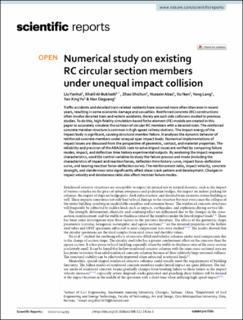| dc.contributor.author | Yanhui, Liu | |
| dc.contributor.author | Al-Bukhaiti, Khalil | |
| dc.contributor.author | Shichun, Zhao | |
| dc.contributor.author | Abas, Hussein | |
| dc.contributor.author | Nan, Xu | |
| dc.contributor.author | Lang, Yang | |
| dc.contributor.author | Yu, Yan Xing | |
| dc.contributor.author | Han, Daguang | |
| dc.date.accessioned | 2023-02-10T12:44:19Z | |
| dc.date.available | 2023-02-10T12:44:19Z | |
| dc.date.created | 2022-09-21T17:27:10Z | |
| dc.date.issued | 2022-08-30 | |
| dc.identifier.citation | Scientific Reports. 2022, 12 (1), . | en_US |
| dc.identifier.issn | 2045-2322 | |
| dc.identifier.uri | https://hdl.handle.net/11250/3050034 | |
| dc.description.abstract | Traffic accidents and derailed train-related incidents have occurred more often than ever in recent years, resulting in some economic damage and casualties. Reinforced concrete (RC) constructions often involve derailed train and vehicle accidents. Rarely are such side collisions studied in previous studies. To do this, high-fidelity simulation-based finite-element (FE) models are created in this paper to accurately simulate the collision of circular RC members with a derailed train. The reinforced concrete member structure is common in high-speed railway stations. The impact energy of the impact body is significant, causing structural member failure. It analyses the dynamic behavior of reinforced concrete members under unequal span impact loads. Numerical implementations of impact issues are discussed from the perspective of geometric, contact, and material properties. The reliability and precision of the ABAQUS code to solve impact issues are verified by comparing failure modes, impact, and deflection time history experimental outputs. By analysing the impact response characteristics, used the control variables to study the failure process and mode (including the characteristics of impact and reaction forces, deflection time history curve, impact force–deflection curve, and bearing reaction force–deflection curve). The reinforcement ratio, impact velocity, concrete strength, and slenderness ratio significantly affect shear crack pattern and development. Changes in impact velocity and slenderness ratio also affect member failure modes. | en_US |
| dc.language.iso | eng | en_US |
| dc.publisher | Nature Research | en_US |
| dc.relation.ispartofseries | Scientific Reports;12, Article number: 14793 (2022) | |
| dc.rights | Navngivelse 4.0 Internasjonal | * |
| dc.rights.uri | http://creativecommons.org/licenses/by/4.0/deed.no | * |
| dc.subject | Civil engineering | en_US |
| dc.subject | Mechanical properties | en_US |
| dc.title | Numerical study on existing RC circular section members under unequal impact collision | en_US |
| dc.type | Peer reviewed | en_US |
| dc.type | Journal article | en_US |
| dc.description.version | publishedVersion | en_US |
| dc.rights.holder | © The Author(s) 2022 | en_US |
| dc.source.articlenumber | 14793 | en_US |
| cristin.ispublished | true | |
| cristin.fulltext | original | |
| cristin.qualitycode | 1 | |
| dc.identifier.doi | https://doi.org/10.1038/s41598-022-19144-1 | |
| dc.identifier.cristin | 2054086 | |
| dc.source.journal | Scientific Reports | en_US |
| dc.source.volume | 12 | en_US |
| dc.source.issue | 1 | en_US |
| dc.source.pagenumber | 1-24 | en_US |

